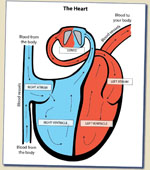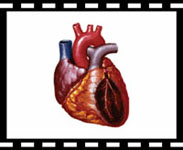| Approach: One to one |
Level:
Year 8
|
|
| Focus:
Understanding body systems |
| Resources: Video recording on laptop computer, heart diagram |
|
|
Questions/instructions:
This activity uses the computer.
You are going to listen to some information about the human heart. Listen carefully to the information. Afterwards, I will ask you some questions about the heart.
Click the Listen to Your Heart! button.
Video voiceover:
Your heart is one of the most important organs in your body. It is really nothing more than a pump. It is made up of muscle which pumps blood throughout the whole body. The shape of your heart is like an upside-down pear. It is near the middle of your chest, just more to the left than to the right.
The heart has two separate pumps, one pump on the right, and one pump on the left. Each pump has two chambers, one on the top and one on the bottom of the heart. Chambers are like pockets. They fill up with blood, then the blood is pumped out of them again. The top chambers are called atria, and the bottom chambers are called ventricles.
|
|
There are tubes called blood vessels leading into and out of your heart. Nearly every part of your body has blood vessels. The blood vessels that take blood from your body back to your heart are called veins. The blood vessels that carry blood from your heart to your lungs then to the different parts of your body are called arteries.
Now remember, the heart has two separate pumps, one on the left and one on the right. Each pump deals with different blood. The right side pump deals with blood that is coming back from around the body. This blood needs fresh oxygen and nutrients. It comes back to the heart from around the body in blood vessels called veins, and then the heart pumps it up to the lungs. As the blood passes through the lungs it gets fresh oxygen and nutrients, then it goes back through the chambers on the left side of the heart. From these chambers the blood with fresh oxygen and nutrients is pumped back around the body in blood vessels called arteries.
Day and night the muscles of your heart pump blood through your body. It beats, or “pumps”, about 72 times per minute. Your heart never stops pumping right throughout your whole lifetime. |
Here is a diagram
of the heart.
Give student the
heart diagram.
Tell me all about how the heart works. You can use the diagram to help you with your explanation. |
 [Click to enlarge picture.]
[Click to enlarge picture.] |
|
|
%
responses
|
| y8
|
Included: |
|
|
Heart is a muscle that pumps blood:
|
both muscle and pump mentioned |
10 |
either muscle or pump mentioned |
46 |
heart has two separate pumps |
25 |
one (pump) on left, one on right |
34 |
| Each (pump) has two chambers/pockets: |
both atrium and ventricle named |
11 |
mentions that there are two chambers |
21 |
heart receives blood from throughout body |
44 |
blood comes to heart in vessels called veins |
30 |
heart pumps blood to lungs |
33 |
the flow from heart to lungs occurs
in vessels called arteries (a vessel called an artery) |
21 |
blood gets oxygen and nutrients in lungs |
42 |
blood comes back to heart from lungs |
14 |
heart pumps that blood to rest of body |
53 |
heart pumps about 72 times a minute (on average) |
22 |
heart will not stop beating while alive |
38 |
Quality of explanation:
|
very good/excellent |
2 |
good |
13 |
moderately good |
38 |
poor |
47 |
|
Total
score: |
12–19
|
4 |
9–11 |
14 |
6–8 |
26 |
3–5 |
35 |
0–2 |
21 |


